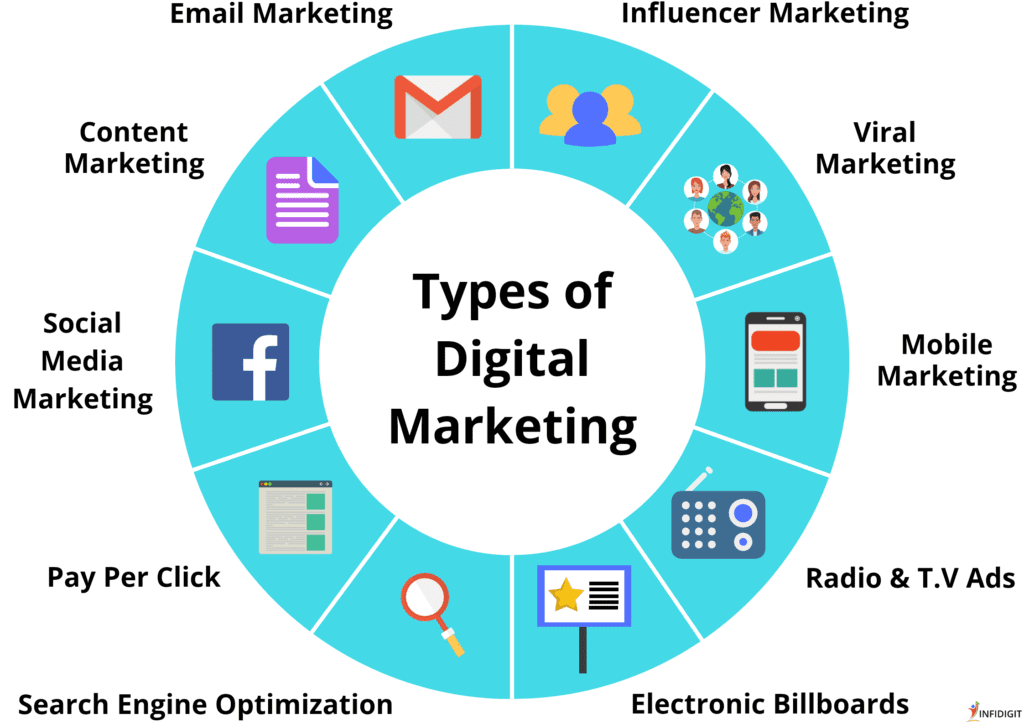Introduction:
Marketing has changed significantly in the modern, fast-paced digital environment. Businesses no longer only use conventional marketing strategies like print ads, billboards, and television commercials. The emergence of digital marketing has completely changed how brands interact with their target market. In order to help businesses comprehend the advantages and efficacy of each strategy, this blog will examine the distinctions between traditional and digital marketing tactics while offering examples and explanations.Traditional vs. Digital Marketing Strategies

Traditional Marketing
Offline strategies that have been employed for decades to advertise goods or services are referred to as traditional marketing. Traditional marketing techniques include, for instance:
Print advertising entails placing advertisements in periodicals, newspapers, brochures, and direct mailers. To reach its target population, a local firm might, for instance, run an advertisement in a neighbourhood newspaper.
Radio and television ads fall under the category of broadcast advertising. To reach a large audience, a vehicle manufacturer, for instance, may run a commercial during prime time.
Outdoor advertising includes banners, posters, billboards, and other forms of signage. An illustration would be a restaurant advertising on a large billboard next to a busy road.
Digital Marketing
Digital marketing involves utilising online channels to reach and engage with the target audience. Here are some key digital marketing strategies:
Search Engine Optimisation (SEO): This focuses on optimising a website to rank higher in search engine results. For instance, a clothing brand may optimize its website to appear on the first page when users search for “stylish fashion trends.”
Pay-Per-Click (PPC) Advertising: This involves placing ads on search engines or websites and paying only when someone clicks on the ad. For example, an online retailer may run PPC ads on relevant websites to drive traffic to their online store.
Social Media Marketing: This includes promoting products or services on social media platforms such as Facebook, Instagram, and Twitter. A beauty brand, for instance, might create engaging content and run targeted ads to reach its audience on Instagram.
Traditional marketing provides a number of advantages of its own, including:
1.Tangibility: The physical presence of print advertisements, billboards, and direct mailers can make an impression on the audience that lasts a long time.
2.Local Reach: When aiming for a local audience, such as one in a particular city or region, traditional marketing techniques might be successful.
3.Consumers are accustomed to seeing print advertisements and television advertising because traditional marketing has been around for a very long time.
Digital marketing gives special advantages that are as follows:
1.Targeted Reach: Using digital marketing, companies may connect with a very particular audience based on their demographics, hobbies, and online habits.
2.Results that are Measurable: With digital marketing, companies can monitor and gauge the effectiveness of their campaigns using analytics tools, giving them important information for campaign optimisation.
3.Cost-Effectiveness: As firms may direct their budgets toward targeted internet advertising, digital marketing can be more cost-effective than traditional strategies.
- Traditional Marketing: a) Print Advertising:
- Discuss the effectiveness of print ads in niche publications and their ability to target specific demographics.
- Explore examples of successful print ad campaigns, such as luxury brands advertising in high-end magazines.
- Highlight the importance of compelling visuals and persuasive copy in print ads.
b) Broadcast Advertising:
- Explain the impact of television and radio commercials on brand awareness and audience reach.
- Discuss the role of storytelling and emotional appeal in creating memorable TV and radio ads.
- Explore the challenges of measuring the ROI of broadcast advertising compared to digital channels.
c) Outdoor Advertising:
- Discuss the advantages of outdoor advertising in terms of reaching a broad audience and generating brand exposure.
- Highlight innovative outdoor ad campaigns that utilize creative and interactive elements.
- Address the integration of digital technologies with outdoor advertising, such as digital billboards and augmented reality experiences.
- Digital Marketing: a) Search Engine Optimization (SEO):
- Explain the importance of SEO in increasing organic visibility and driving targeted traffic to websites.
- Discuss the key elements of SEO, including keyword research, on-page optimization, and link building.
- Provide case studies of businesses that have successfully improved their search rankings and organic traffic through SEO strategies.
b) Pay-Per-Click (PPC) Advertising:
- Detail the benefits of PPC advertising, such as immediate visibility, precise targeting, and measurable results.
- Explain the process of setting up and managing PPC campaigns, including keyword selection, bid management, and ad copy optimization.
- Provide examples of industries that have seen significant success with PPC advertising, such as e-commerce and B2B services.
c) Social Media Marketing:
- Explore the power of social media platforms in building brand awareness, fostering customer engagement, and driving conversions.
- Discuss the different social media channels and their suitability for various business types and target audiences.
- Highlight successful social media campaigns that have effectively utilized engaging content, influencer collaborations, and user-generated content.
- Integrated Marketing:
- Emphasize the importance of integrating traditional and digital marketing strategies for a cohesive brand message.
- Discuss how traditional and digital channels can work together to amplify brand reach and engagement.
- Provide examples of successful integrated marketing campaigns that leverage both online and offline channels.
While conventional marketing is still useful in some situations, digital marketing has emerged as a crucial element of contemporary business expansion.Businesses need to utilize a hybrid approach that combines the best aspects of traditional and digital marketing. By understanding the differences and benefits of each technique, businesses can create comprehensive marketing plans that successfully reach and engage their target audience, resulting in business growth in the digital age.digitalmarketi
Businesses may position themselves for success and stay ahead in today’s competitive market by creating a well-rounded marketing strategy that blends the best of traditional and digital tactics.Creating a Branding Strategy
